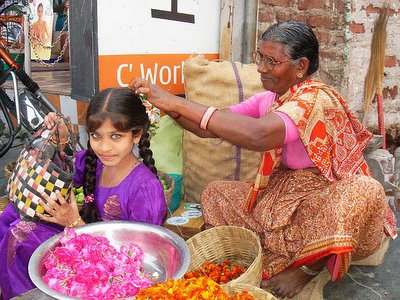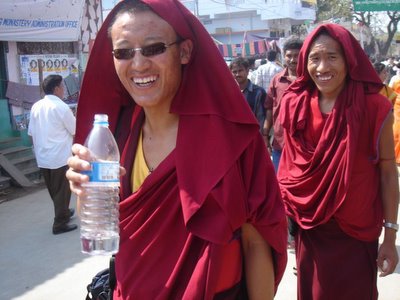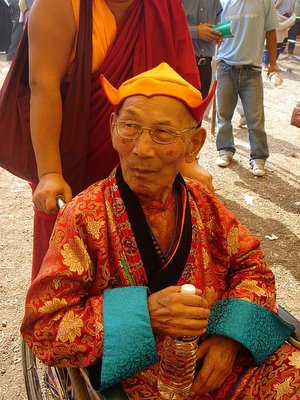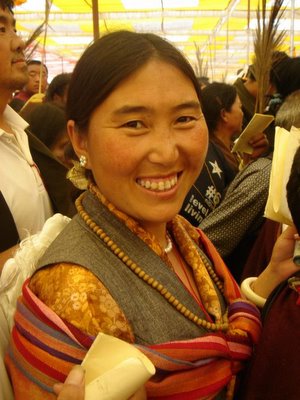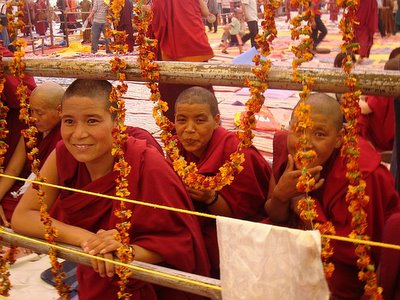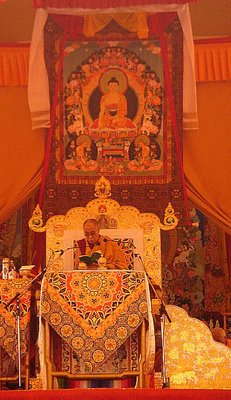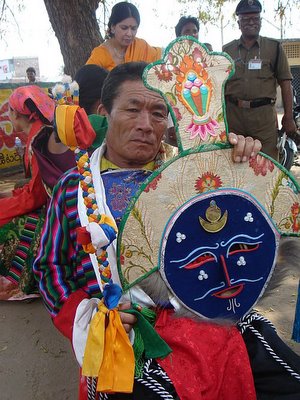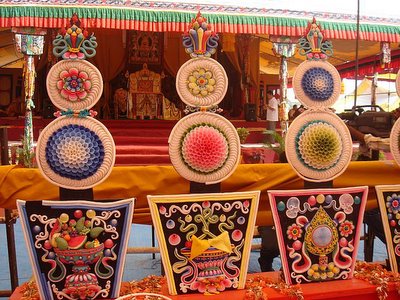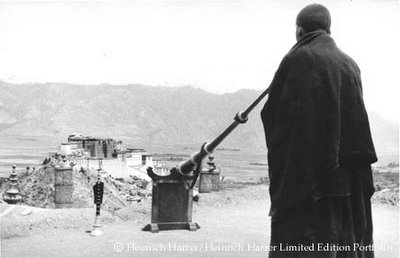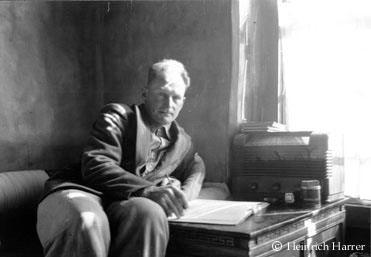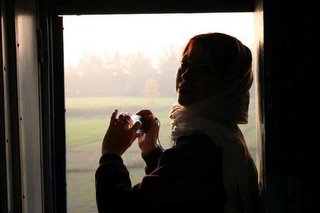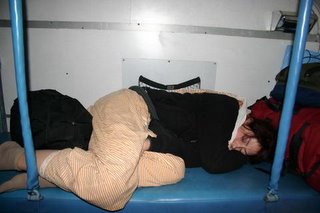 Amaravati, Andhra Pradesh
Amaravati, Andhra PradeshI made it! - just arrived this morning on the bus from Guntur. A local Hindu man who was also travelling to
Amaravati took it upon himself to guide me from Hyderabad's Central Bus Stand to the correct bus, then the change in Guntur, and even carried my backpack to the bus(those of you who haven't been to India may not appreciate this - only "coolies" carry stuff here).
My striped circus tent (sleeps 10) needs floor matting and has no electricity, and we use the latrine/public bath, which is a concrete cubicle with just a spigot, no actual showerhead.

I'm Tent #407 - but the tent city is enormous, fields of canvas among yucca plants and palm trees. In case that sounds lovely and sylvan, I should mention the latrines and dust. In fact, it's mostly dust. I have to find my way among the endless rows of "meals hotels," village houses and clothes vendors, all of which are erected for the occasion from bamboo poles, canvas sheeting and tarps. It's fun to watch the Buddhist nuns shop for jeans (where will they wear them? I can't help wondering). My tent is located back behind a row of local houses made of thatch roofs with concrete floors and water buffalo grazing in the sideyards. Locals are so amused that I would want to snap a photo of a baby water buffalo; sort of like someone coming to Tennessee and wanting to photograph a pickup truck - it's nothing special here.
As the tents were pitched in the middle of an ordinary field they have the added bonus of cow manure on the "floor." Knowing as I do of the sacred and healing properties of cow dung, I considered this auspicious.
Lots of locals are renting out rooms in their houses, even their whole houses while they sleep on the porch. It's possible to rent a clean room in a village house, with running water and private Indian village style bath (that means cold water bucket bath from a pump and squat toilet) and electric, for $100 for the entire 16 days. (This is good for this special event, but a fortune for India! Such a room would rent for about $20 a month normally). Two people or more can sleep in such a room.
Buddhist compassion takes interesting forms; for the residents this could be a chance to make more money in 2 weeks than they normally make in 6 months.
Andhra is a poor state with one of the lowest literacy rates. Suicides among hopelessly indentured farmers, made desperate from the droughts, soared into the 1000s here in the past few years.

After stumbling down from the bus lopsided with my backpack, I had breakfast on the side of the dirt road with a bunch of monks who had come straight from Kham district, Tibet. They spoke "little little English" but were a good-natured, thigh-slapping bunch who readily made a place for me and my junk on the roadside charpoy (a sort of Indian cot). They were fulfilling the dream of a lifetime - to see the Dalai Lama, whose name and photo are forbidden now back in Tibet. Breakfast was 2 idlis (steamed rice cakes) with coconut chutney made in the fiery Andhra style (inedible to me - Andhra chilis are weapons of mass destruction) and tiny plastic thimbles full of chai. All the public announcements and most of the signs are in Tibetan so I guess I will be learning a little Tibetan as well as Telugu in the next 2 weeks. It was satisfying to have my few words of Tamil and Malayalam return magically to my brain and be understood by the local people, who at least appreciated my attempts to speak a Southern language. Since many visitors are here from Tibet, Japan, Thailand, China, Singapore and elsewhere photos of the Buddha were helpfully taped onto the local buses headed this way (normally all the signs are in Telugu). The Enlightenment Express!

This has been declared
a Vegetarian Kalachakra which must be a challenge for the meat-loving Tibetans. There are signs everywhere in Tibetan, Telugu, Hindi, English and Chinese
saying "stop meat, save animals!" and "animal rights, human wrongs!"
More later, I need to go get registered and get a map of this enormous site. There is so much dust here in dry Andhra that this computer keyboard has to be encased in a plastic bag, and about fifty percent of the attendees are walking around in surgical masks.
...Later...Wow, I am knackered after a few hours spent in the midday sun. Amazing how quickly you dehydrate even just strolling around in such weather. I was a good alien and went to the Foreigner's Registration Cell, just a tent with a sandy floor and the

usual molded plastic furniture. Turns out I needed 2 passport photos (note to self: never travel without these, you never know when you'll need them. Really) and photocopies of my passport and visa. Felicity (a delightful South African woman who used to teach English in post-independence 1960's Zambia) and I accomplished this with a stroll "downtown." Suresh the photocopy man had icons of Shirdi Sai Baba and
Amma & Bhagawan ("very powerful darshan") on his walls. He highly recommended I pay Amma & Bhagavan a visit at their Golden Temple in Chennai. Across the street, the passport photo man took his job extremely seriously.
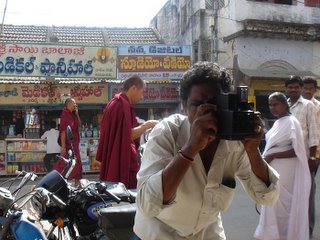
Using an ancient hand-held Polaroid, he produced 4 copies of the Polaroid photos for 50Rs (about $1.10). We then returned to the "cell" just in time for the "in-charge," who had been examining every single application as though it were written in Farsi and studiously refusing to allow anyone to use his ink pen, decided he was taking lunch (at 3pm).
That was my cue to shuffle back through the dust to take my second "shower" of the day (really just splashing water from the knee-level tap over my body). At about 5.30 pm I saw a wave of Tibetans coming from the KalaRanga (Arts Stage). His Holiness had given an inaugural speech, and it was never even announced! Judging from the crowd moving my way, the only people who heard this at all were the Tibetans. I felt cheated and disappointed as waves of devotees came toward me. The Tibetans in their heavy dress were interwoven with Andhra people of all sorts, Muslims in white kufis and kurtas, Hindus with various tilak-marks on their foreheads, Om Shakti pilgrims (who dress all in red), Sabarimala pilgrims (dressed all in black), all drifting toward me as evening sandhya music played over a loudspeaker. Sandhya (dusk) devotional music is full of yearning, longing and wistfulness. To hear it as the brutal sun vanishes, the day's dust settles and purple twilight takes its place is always a magical moment for me.

I decided to forget my disappointment in missing the speech and enjoy the impromptu parade of traditional costumes, twirling prayer wheels, high cheekbones and almondeyes from across the Asian plateau. The Ladakhis wear completely different dress from the Tibetans - a heavy black skirt - and many women sported the traditional silver finery in their long braids and around their waists. Their ability to wear such weighty clothing, heavy skirts and chunky shoes in any kind of weather truly amazes me.
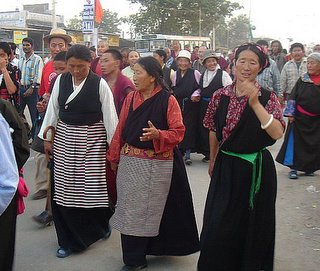
The sight of all these Tibetans mingling with Indians reminded me of India's amazing ability to absorb various influences, and of the episode in the Dalai Lama's autobiography, describing his entry into India after his escape in 1959. When he got to Delhi, he was shocked and moved to tears to find the streets lined with Hindus and other Indians shouting "Dalai Lama Ki Jai! Dalai Lama Zindabad!" ("long live the Dalai Lama"). At this point, Buddhism had almost obsolete in India for 1000 years. Despite all its own problems, including those of population and land distribution, the newly independent India managed to incorporate these people and find a home for them. It was partly out of mutual alliance against the Chinese, but also out of respect for Buddhism, a faith that originated in India, moved elsewhere and was now returning "home." Indians of all beliefs seem to harbor an almost automatic respect for any holy person, whether it be the Pope, Mother Theresa, or this century's incarnation of the Living Buddha.
I made my way into "town" (downtown Guntur, a row of ragtag shops) to buy mosquito coils and a straw floor mat for my tent (total cost: 60Rs, about $1.50). A power outage transformed the main street into a candlelit row, which is probably how it looked all the time 30 years ago. The shop I chose to buy from was run by three women with not a man in sight - very unusual. Most women are married here by age 23 or so and once they're married, they usually do not work outside the home. "Ladies' shop!" I exclaimed. They nodded proudly. "Sisters? Munna sisters?" (three sisters?) I asked. Yes, they laughed and smiled. "I also am having three sisters! Oru akkaiah, oru thamudi" (one elder, one younger). If you can't talk about cricket, you can always connect with Indians by discussing family.
Back in the circus tent I collapsed onto my new straw mat and continued reading the Kalachakra book ("An engaged practitioner is more interested in helping others than in satisfying selfish desires"). A voice from the "door" scared the hell out of me. It was a Tibetan teenage boy who wanted to know how much I had paid for my tent. Problem was he couldn't understand my answer. Then he started talking about mosquitoes being a problem (deciphered through hand gestures and the word "mozzkito") so I gave him a coil and showed him how to use it. I tried to return to reading my book, but he then pulled out wrinkled photocopy of English homework and asked me to correct it.
"They had a good time. They enjoyed __________." "Themselves," I wrote in the blank. Most of his answers were perfect, though. Rinchen Tsangpo turned out to be in a neighboring tent, #387, with four other Tibetan boys. He didn't take repeated hints that I was ready to fall asleep. I began to wonder if he was coming onto me, or just wanted help with his homework. Possibly both?
